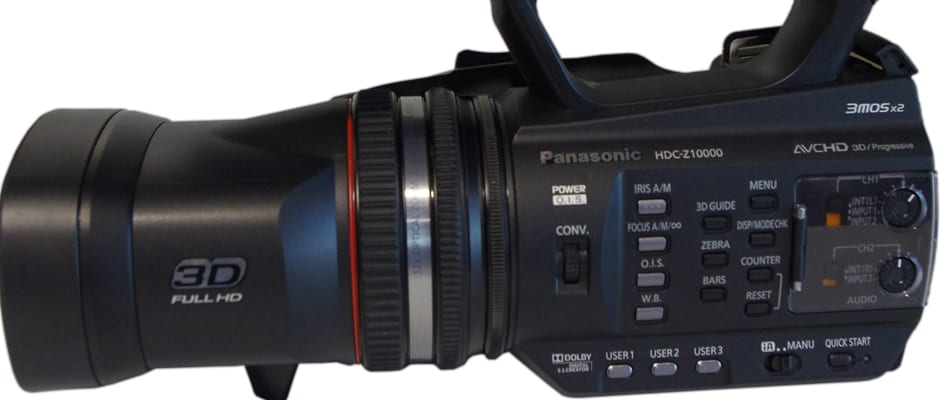Introduction
Lens & Imaging System
{{section_header}}{{section.name}}{{/section_header}}

To record a 3D image, the HDC-Z10000 makes use of a dual lens system—just like the other high-end and professional 3D camcorders that have hit the market over the past year. The sensor system on the Z10000 is even more unique, however, as the camcorder employ's two of Panasonic's 3MOS chip array. This means the model is loaded with a total of six 1/4.1-inch CMOS sensors, each with a pixel count of 3.05 megapixels (three sensors for each lens). It sounds a little over the top, but it makes sense when you think about it. Panasonic is simply doubling up on its 3-chip system with the Z10000 in order to make it capable of recording Full HD 3D video.
Front
{{section_header}}{{section.name}}{{/section_header}}
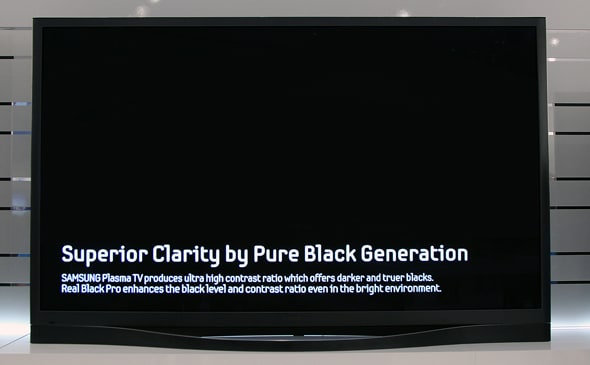
Right
{{section_header}}{{section.name}}{{/section_header}}
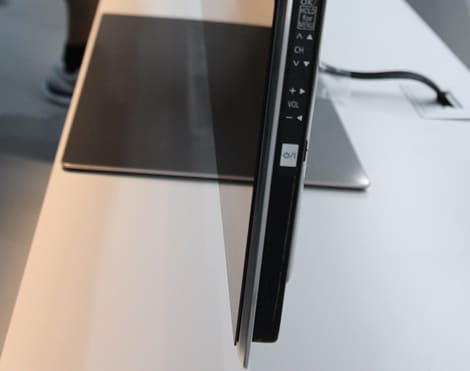
Back
{{section_header}}{{section.name}}{{/section_header}}
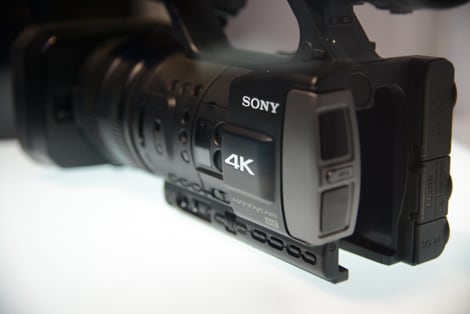
Left
{{section_header}}{{section.name}}{{/section_header}}
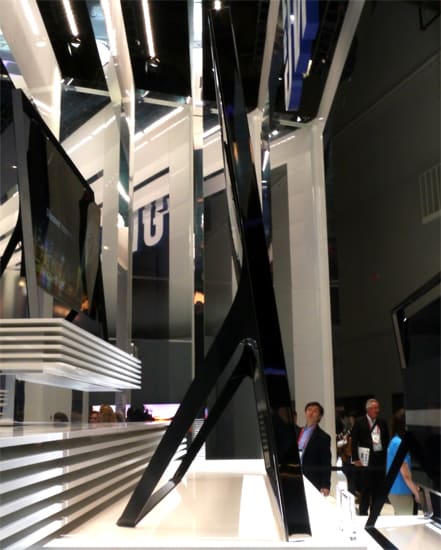
Top
{{section_header}}{{section.name}}{{/section_header}}

Bottom
{{section_header}}{{section.name}}{{/section_header}}
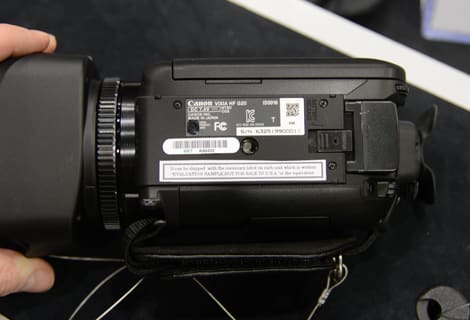
Compression
{{section_header}}{{section.name}}{{/section_header}}
The Z10000 is AVCHD compliant for all HD recording on the camcorder—even for 3D and 1080/60p progressive recordings. This is possible because the camcorder uses the new AVCHD 2.0 standards that have specific regulations for the recording of 3D and progressive Full HD video. It's also the same recording standard you'd find on Panasonic's consumer 3D camcorders (like the HDC-SDT750 or the TM900 using the 3D lens adapter) as well as other consumer 3D camcorders (like the Sony HDR-TD1). The AVCHD 2.0 standards set 3D recording options at 1080/60i, 1080/24p, or 1080/30p. There is not an option for recording 3D video with a 60p frame rate.
Read more about the advantages and disadvantages of different compression types.
In addition to 3D recording, the HDC-Z10000 is capable of recording Full HD video in 2D using a variety of different frame rates and quality settings. The camcorder has a 1080/60p mode that is identical to the mode you'll find on Panasonic's top-line consumer camcorder, the HDC-TM900. However, the Z10000 also has additional native 24p and 30p record options that aren't available on Panasonic's consumer camcorders.
Media
{{section_header}}{{section.name}}{{/section_header}}
Being a camcorder geared to pros or serious videographers, the HDC-Z10000 does not come equipped with any internal memory. Instead, the camcorder is outfitted with two memory card slots, both of which will work with any SD-type memory cards (including new high-capacity SDXC memory cards). This is one feature that sets the Z10000 apart from the more expensive professional models from Panasonic, many of which us P2 cards to record HD video (using a different compression system than AVCHD). We like the presence of SD card slots on a camcorder in the Z10000's price range. SD cards are cheap, easy to find, and most people are comfortable working with them on all kinds of devices.
Read more about the advantages and disadvantages of different media types.

With the dual card slot system, you can have the camcorder record your video clips simultaneously on two cards (one acting as a back-up of the other), or you can use a relay record system that automatically has the camcorder continue recording onto the second card when the first one fills up. Even if you're in the midst of recording a single video clip when the switchover to a new card occurs, the camcorder won't lose a second of the recording. And when you bring those clips into an editing program from the two cards, they can easily be stitched back together as one file.
Editing
{{section_header}}{{section.name}}{{/section_header}}
We've complained in the past about the inability to edit 60p video clips shot with Panasonic camcorders, and, while the format is still unusable with most editing software, we have found that Adobe Premiere has the ability to import and edit 1080/60p clips. 3D video poses its own challenges when it comes to editing, although Panasonic does include a program with the Z10000 that allows you to import your clips and do some basic editing.
Auto Mode
{{section_header}}{{section.name}}{{/section_header}}
The Z10000, like most Panasonic camcorders, has a dedicated auto mode called iAuto (Intelligent Auto). The mode functions well-enough for most shooting situations, but this is a camcorder geared towards pros rather than beginners, so we doubt many users will be focusing most of their time on using the iAuto mode with the Z10000. The mode works for 2D or 3D recording, and it essentially locks you out from entering the extensive camera settings menu, which is where all the pro-level controls are found.

Zoom
Zoom Ratio
{{section_header}}{{section.name}}{{/section_header}}
The camcorder features a 12x zoom in 2D mode and a slightly-limited 10x zoom when recording 3D video. Both of these zoom lengths are fairly good compared to the competition, and it represents a huge improvement over Panasonic's consumer 3D camcorders, which offer no optical zoom in 3D mode.
Focus
{{section_header}}{{section.name}}{{/section_header}}
The largest lens ring on the camcorder, the one closest to the front of the lens, is the focus ring. We liked the way the focus ring felt for adjusting focus. It was smooth, but had the right amount of friction to make precise adjustment of focus relatively easy. Adjusting focus in 3D mode is possible, but we recommend switching the LCD off of 3D view if you plan on doing so. It is very difficult to see how crisp your subject is when you're looking at the 3D view on the LCD (you could also look through the viewfinder as well).
Exposure
{{section_header}}{{section.name}}{{/section_header}}
We couldn't find a basic exposure adjustment option on the HDC-Z10000, so the feature is either not available or it's buried in the extensive menu system. Either way, the camcorder does offer extensive manual controls over aperture, gain, and shutter speed, so basic exposure adjustment isn't all that necessary. Still, we'd like the feature to be present, if only for people who want to quickly adjust the brightness of their image in auto mode.
Aperture
{{section_header}}{{section.name}}{{/section_header}}
At PhotoPlus, Panasonic expressed pride in its ability to construct the HDC-Z10000 with a very fast lens. The lens has a wide aperture of f/1.5, which enables the camcorder to absorb a ton of light in both 3D and 2D record modes. This stands in stark contrast with Panasonic's consumer camcorder lineup that can record 3D with a lens adapter. Those camcorders, like the HDC-SDT750 or the HDC-TM900 (with adapter), require far more light when recording 3D video compared to 2D. With the Z10000, shooting 3D video in less than ideal lighting conditions shouldn't be an issue. We shot some impressive 3D video under bland, fluorescent lighting in an office-like atmosphere when we got a hands-on with the camcorder.
Aperture can be adjusted automatically or manually on the Z10000, and the camcorder has full manual aperture control in 3D mode as well as 2D mode. You can even set the aperture during recording of 2D or 3D video, which is something you don't always have the option of doing with consumer models. If you continue to open the aperture beyond its widest setting of f/1.5, the aperture control switches over to gain adjustment (yes, the two controls are tied together). This is the same thing that happens on the Panasonic HDC-TM900 and other consumer camcorders from Panasonic.
Shutter Speed
{{section_header}}{{section.name}}{{/section_header}}
Like aperture, full manual shutter speed control is available on the HDC-Z10000 for both 2D and 3D recording. Our main gripe is that the slowest shutter speed option on the camcorder is 1/30 of a second, which means you can't create a blurry, slow-shutter effect if you so desire. You'd think a pro-level model like the Z10000 would allow for this kind of feature. Instead, the shutter speed range is 1/30 to 1/8000 for most recording, while a shutter speed of 1/24 of a second is available when using the 24p frame rate option.
Unlike focus, zoom, and aperture, there's no dedicated lens ring for adjusting shutter speed control on the Z10000. This means you have to use the dinky touchscreen controls to set the shutter speed for the camcorder. We're not saying the touchscreen is awful, we just think there should be a better option for setting a control like shutter speed on a prosumer camcorder like the Z10000.
White Balance
{{section_header}}{{section.name}}{{/section_header}}
In addition to auto and manual settings, the Z10000 has two white balance presets: 3200K and 5600K. You can also store two manual white balance settings on the camcorder at the same time, which is pretty standard for a pro camcorder. Having two stored white balance settings allows you to move between two different light setups (with different color temperatures) rather quickly.
Gain
{{section_header}}{{section.name}}{{/section_header}}
You won't find a dedicated gain control on the HDC-Z10000. Instead, the camcorder's gain control is tied to its aperture adjustment, which means if you continue to open the aperture beyond its widest setting the camcorder will switch over to adjusting gain. Panasonic does the exact same thing on its consumer camcorders, and, frankly, we're not that impressed by this limited gain control. We were hoping to see a fully manual gain control option on a camcorder of the Z10000's caliber, and the fact that gain is tied to aperture makes the feature less versatile.
Other Manual Controls
{{section_header}}{{section.name}}{{/section_header}}
The has a decent set of color and image controls, as well as professional control features that you won't find on Panasonic's consumer camcorders (like the TM900). These controls, most of which are located in the camera menu, allow you to fine tune your image and go further than the basic aperture, shutter speed, gain, and white balance settings. Some of the controls in this menu include: detail level, coring, chroma level, chroma phase, color temperature, master pedestal, auto iris level, dynamic range stretch (DRS), gamma control, knee adjustment, color matrix, and skin tone detail. After setting a variety of these controls, you can save every detail as a "scene." You can then have multiple scene settings saved and switch between them with ease (e.g. one for outdoor shooting, one for indoor shooting, etc.).
In addition to all these controls, the camcorder also has two zebra settings, color bars, three user-assignable buttons, and a ton of audio controls.
3D Lens
{{section_header}}{{section.name}}{{/section_header}}
The Z10000 has a dual lens system, which is why you see two identical lenses when you look at the front of the camcorder. The lenses have a wide aperture of f/1.5 each (for both 2D and 3D recording), and the only only real difference in their specs when shooting 3D is that the optical zoom is limited to 10x (it's 12x for 2D recording). Impressively, the camcorder has the ability to record 3D imagery on a subject that is just 45cm away, as long as the camcorder's macro mode is engaged. For regular 3D recording, the minimum shooting distance is 2.5 meters.

The dual lens system makes 3D recording a reality on the Z10000.
Since the dual lens system is built into the camcorder itself, the Z10000 requires little to no calibration or setup when you switch over to 3D record mode. Compare this to the extensive setup process required by the HDC-SDT750 or any camcorder in Panasonic's lineup that can work with the VW-CLT1 3D lens converter. The camcorder comes with a removable lens cap, rather than having a built-in cap that automatically opens and closes. We like the removable cap for a pro model like the Z10000.
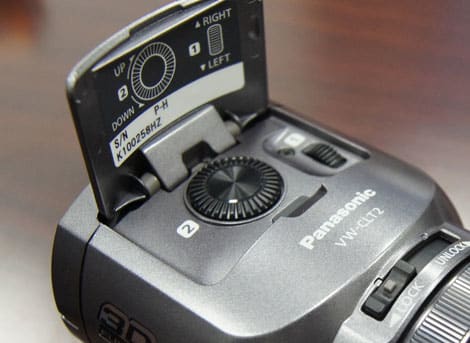
3D Controls
{{section_header}}{{section.name}}{{/section_header}}
As far as we can tell, the HDC-Z10000 has a full suite of manual controls in 3D record mode. This means you can adjust aperture, shutter speed, focus, and white balance in 3D mode just like you can in 2D mode. The only limitation is the optical zoom, which is reduced to 10x for 3D recording (it's 12x in 2D recording).
The Z10000 also has a convergence adjustment feature that allows you to manually control the 3D effect produced by the camcorder. This feature is common on 3D camcorders, but we were impressed by the system on the Z10000 for two reasons. Firstly, the camcorder will warn you if you if the convergence levels aren't at an ideal setting for 3D recording (either too much adjustment or too little). Secondly, the camcorder's LCD has two different 3D viewing options to assist you with recording 3D video and adjusting the 3D effect.
{{product.manufacturer_specs['FI 3D Physical Controls Image']}}{{product.manufacturer_specs['FI 3D Physical Controls Image 2']}}
Like the Sony HDR-TD10 and the JVC GS-TD1, the Panasonic HDC-Z10000 has an 3D LCD that doesn't require special glasses to view the 3D image. The quality of the 3D on the LCD isn't fantastic, but we liked it about as much as we liked the 3D screen on the Sony TD10, which was a lot better than JVC's 3D screen on the TD1. Panasonic takes things a step further on the Z10000, however, by offering a second 3D view mode called 3D Mix that shows you an overlapped image of your two recordings (basically, the view from each lens on the camcorder). This view is great for adjusting the convergence, as it provides the perfect visualization of what each lens is recording and how the overlapping of each image is creating the 3D effect.
{{product.manufacturer_specs['FI 3D Controls Menu Image']}}
3D Playback
{{section_header}}{{section.name}}{{/section_header}}
We didn't get a chance to do much with the playback mode on the Z10000, but Panasonic claims the camcorder should function fine when connected to any 3D television (not just Panasonic models). When we hooked the Z10000 up to a Panasonic 3D television, the TV did recognize the camcorder immediately—and switched into 3D mode when we viewed our 3D recordings.
{{product.manufacturer_specs['FI 3D Playback Menu Image']}}
Ease of Use
{{section_header}}{{section.name}}{{/section_header}}
Obviously, the HDC-Z10000 isn't the easiest camcorder to use—it is a model geared towards pros, after all—but we do like the fact that Panasonic went ahead and included the dedicated auto mode (iAuto) on the camcorder anyway. For serious videographers, the Z10000 probably won't be all that much of a challenge to figure out, but there were a few design flaws that we found problematic. Primarily, we were surprised to find the camcorder lacked a dedicated button to switch between 3D and 2D recording. We understand that the target audience for the Z10000 may not need such an easy-to-locate button, but we feel it should have been included. Instead, the option for switching to 3D mode is found in the camcorder's menu system, which isn't the easiest to navigate.
We should also note the Z10000 comes equipped with a touchscreen LCD, which is something you more commonly see on consumer models rather than camcorders that cost over $3000 dollars. The touchscreen is fairly responsive, but we still don't like using it for adjusting controls. Thankfully, most of the important controls on the Z10000 can be altered using lens rings, dials, and buttons rather than the touchscreen. There are a few controls, however, that you need to use the touchscreen for (shutter speed is one of them), and we didn't find this to be the most precise method for setting such controls.
Handling
{{section_header}}{{section.name}}{{/section_header}}
For a big, pro-level camcorder, the HDC-Z10000 feels balanced in the hand. The handlebar is decent too, especially for transporting the camcorder. As a pro model, the camcorder is equipped with a ton of buttons, three lens rings, and an extensive menu system loaded with controls. The lens rings are our favorite of the camcorder's handling features, and they work well for adjusting focus, aperture (iris), and zoom. What bothered us, however, was the fact that other important controls—like shutter speed—had no dial or ring that could be used for adjustment. We don't like having to resort to using the touchscreen LCD to set important controls, as it simply doesn't provide the accuracy or speed that a lens ring offers.
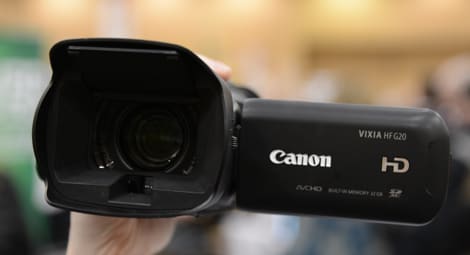
Our biggest problem with the Z10000's interface is the hassle of using the touchscreen interface to navigate and adjust options on the camcorder's extensive menu system. The menu is easy to figure out, as it's just a page-by-page list of options, but there are so many options that it is easy to get frustrated trying to find the setting you're looking for. This is more of a problem with the Camera Settings menu than anywhere else on the camcorder. This menu contains the professional-grade controls, like gamma adjustment and color temperature options, that you won't find on most consumer models. There are so many controls here, and many of them are meant to be adjusted in correlation with each other, which makes the page-by-page menu structure difficult to use (you can't see the big picture).

Overall, the Z10000 is a good camcorder in terms of how it feels and how it is constructed, but we wish there were more dials, more switches, and a better interface than a touchscreen for adjusting many controls.

Stabilization
{{section_header}}{{section.name}}{{/section_header}}
Panasonic has a brand new stabilization system on the HDC-Z10000 called Hybrid OIS +. The "plus" means that Panasonic added a new feature that corrects for horizontal roll of the camcorder (if you tilt the camcorder from side to side). The stabilization system also corrects for vertical tilt, as well as x and y-axis shake, but those were all part of Panasonic's previous Hybrid OIS system. Unfortunately, the Hybrid OIS + only works for recording 2D video. In 3D mode, the camcorder utilizes a Powered OIS system, which allows you to provide a boost to the OIS with the touch of a button.
Portability
{{section_header}}{{section.name}}{{/section_header}}
Like most camcorders in its price range, the Z10000 is a big camcorder that weights over 3.5 pounds (1600g) without a battery pack. It's a hefty load to carry in your hand, but the grip on the camcorder is quite good, so it remains well-balanced even after your hand gets a little tired. The overall dimensions for the camcorder are 145 x 195 x 350mm (5.7 x 7.7 x 13.8 inches). Obviously, this is a camcorder that will require a carrying case or some kind of bag to transport it comfortably, but we felt the handlebar on the top of the camcorder worked well as a grip.
Battery
{{section_header}}{{section.name}}{{/section_header}}
The battery compartment for the HDC-Z10000 is cavernous, but that's a good thing because it means the camcorder can accommodate very large battery packs. The battery pack we used with the camcorder was huge, as you can see from the photo, and it added a significant amount of weight to the camcorder. We can't attest to how long a battery pack like this would last with the Z10000, but Panasonic claims you can record for over five hours with a fully-charged battery (at the highest quality setting).
Our only problem with the battery has to do with Panasonic's inane decision to place the DC-input for the camcorder deep inside the battery compartment. This means you a) can't access it when a battery pack is loaded in the camcorder, and b) it's still a pain to get to even when there's no battery loaded in the camcorder in the first place. It's an awful placement decision in our opinion, and we wish Panasonic had put the DC-input on the side of the camcorder instead.

LCD & Viewfinder
{{section_header}}{{section.name}}{{/section_header}}
The specs and features for the LCD on the Z10000 are great: glasses-free 3D display, 3.5-inch screen, and a 1,152,000-pixel resolution. The screen also features an interesting "tuck-in" design that has it slide into the a portion of the camcorder's handlebar when the screen isn't in use. This design, while kind of cool, wasn't something we were head over heels about. The sliding mechanism on the LCD panel didn't feel that strong, and we occasionally had trouble tucking the screen away when we were done with it. We'd rather have a simple hinged LCD panel like you get on a consumer camcorder because, at least to us, that design feels less likely to break.

The electronic viewfinder on the camcorder provided a crisp image with its 1,226,880-pixel resolution, which just so happens to be an even more resolute image than is shown on the camcorder's LCD. Unfortunately the viewfinder did not extend or move side to side on the Z10000, but it did pivot up and down adequately. We also liked that it jutted out from the camcorder far enough that even a large battery pack shouldn't be in its way. The viewfinder on the Z10000 we got to play with at the Photo Plus Expo (shown in photos) didn't have an attached eyepiece, but Panasonic does ship a large eye cup with the camcorder.


Audio Features
{{section_header}}{{section.name}}{{/section_header}}
The HDC-Z10000 has plenty of professional-grade audio controls and features, including two XLR inputs and a 5.1-channel built-in microphone (both of which are located on the handlebar). The XLR ports include phantom power and there's an section on the camcorder's body dedicated to adjusting audio levels and controls. The one thing that bothers us is that the Z10000 does not have a 3.5mm external mic jack, but you could always purchase an XLR to 3.5mm cable and hook up a mic to the camcorder that way.

Connectivity
Conclusion
In our time with the HDC-Z10000, we were impressed by the camcorder's plethora of manual controls, excellent set of features, and very good performance in 3D record mode. We have not tested the camcorder at this point, but we were able to shoot some video with the Z10000 and watch it on a 3D TV during our hands-on with the product. Even under some awful lighting conditions (fluorescent office lighting), the camcorder's 3D images looked solid, and we found the 3D effect to be more prominent than what we shot with the Sony HDR-TD10 or the JVC GS-TD1. Of course, this was just a "first impression" of ours, and, again, it was not based on any in-depth or lab-based testing.
In our reviews of dual-lens 3D camcorders earlier this year, we expressed skepticism of their usefulness to consumers. Why would anyone want to lug around a bulky camcorder that has two lenses, especially if you're not planning on shooting that much 3D footage? Well, with the HDC-Z10000 we are revising our thoughts a bit. The size and weight added to the HDC-Z10000 from the second lens isn't all that significant as a whole. The camcorder is a pro model, so it would need to be somewhat hefty to begin with, just to accommodate all the buttons and handling features. For this reason, the Z10000 doesn't feel overly large or bulky compared to the competition.
We like to think the Z10000 would be a good camcorder even without its ability to record 3D video. We're not sold on the benefits of 3D recording at this point, so the camcorders that have marketed themselves solely as "3D recording devices" haven't really piqued our interest. The Z10000, on the other hand, looks to be a top-notch prosumer model for 2D recording, so even if you forget everything about 3D, you've still got a quality camcorder on your hands. The same thing could be said about the Sony HDR-TD10 or JVC GS-TD1, but those models felt so awkward and handled so poorly that we couldn't imagine anyone using them for anything other than shooting 3D.
Our problems with the Panasonic HDC-Z10000 should be noted. We don't like the touchscreen LCD, we had some issues with finding menu options and changing controls, and we wish there were more dedicated buttons or dials for changing important settings. Other than that, the Z10000 looked like a great camcorder based on our brief encounter with the model. It's $3500 price tag is fair for what you get, although it is clearly being marketed for professionals, student filmmakers, or serious videographers.
Photo Gallery
{{photo_gallery "FI Lens Image", "FI Front Image", "FI Right Image", "FI Back Image", "FI Left Image", "FI Left Open Image", "FI Top Image", "FI Bottom Image", "FI Media Image", "FI Easy Mode Image", "FI Zoom Image", "FI Zoom Image 2", "FI 3D Lens Image", "FI 3D Lens Image 2", "FI 3D Physical Controls", "FI 3D Physical Controls 2", "FI Handling Image", "FI Handling Image 2", "FI Handling Image 3", "FI Battery Image", "FI LCD Image", "FI Viewfinder Image", "FI Viewfinder Image 2", "FI Playback Image", "FI Mic Image", "FI Flash Image", "FI Photo Mode Image", "FI Ports Image 1", "FI Ports Image 2", "FI Ports Image 3", "FI Ports Image 4", "FI Ports Image 5", "FI Ports Image 6"}}
Specs
{{manufacturer_specs_table}}
Meet the tester
Jeremy is the video expert of our imaging team and Reviewed.com's head of video production. Originally from Pennsylvania and upstate NY, he graduated from Bard college with a degree in film and electronic media. He has been living and working in New England since 2005.
Checking our work.
Our team is here for one purpose: to help you buy the best stuff and love what you own. Our writers, editors, and lab technicians obsess over the products we cover to make sure you're confident and satisfied. Have a different opinion about something we recommend? Email us and we'll compare notes.
Shoot us an email
